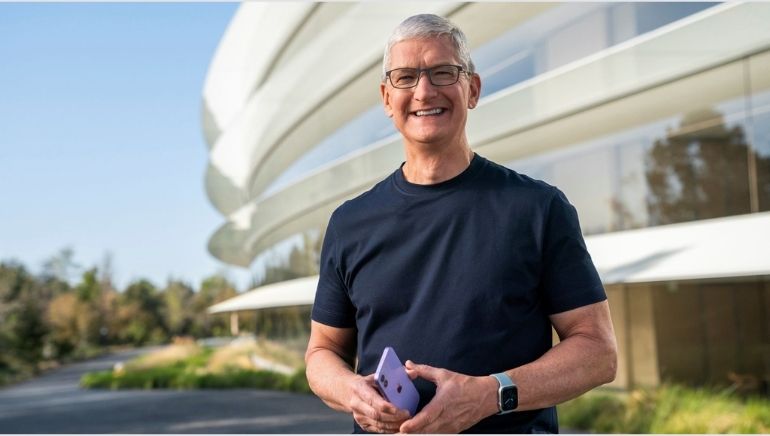One of the most successful CEOs in the world, Tim Cook began as the Chief Executive Officer of Apple Inc. in 2011. A story from innovation to dominance, he previously served as the company’s Chief Operating Officer under its Co-Founder Steve Jobs. His journey from an engineer to the CEO of Apple Inc. showcases his dedication to innovation, operational excellence, and ethical leadership. His ability to navigate challenges, maintain a customer-centric approach, and uphold the company’s core values has contributed significantly to the brand’s continued success
BY JYOTI VERMA
As Apple CEO, Tim Cook has been responsible for leading one of the world’s most innovative and creative companies. While Steve Jobs is often associated with Apple’s initial groundbreaking products and creative culture, Tim Cook’s leadership has also played a significant role in fostering and maintaining the company’s creativity. Under his leadership, Apple has continued to introduce new and innovative products, such as the Apple Watch, AirPods, and various iterations of the iPhone and iPad. He has been known for his meticulous attention to detail and his focus on operational excellence, which has allowed Apple to maintain its high standards of design, quality, and user experience across its product lineup.
The Apple CEO has also shown a commitment to sustainability and social responsibility, pushing Apple to become more environmentally friendly and ethical in its practices. He has championed renewable energy initiatives, reduced the company’s carbon footprint, and taken steps to improve working conditions within Apple’s supply chain.
In terms of fostering a creative environment within Apple, Cook has encouraged collaboration and diversity among employees. He has supported initiatives that promote inclusivity and the sharing of ideas, recognising that a diverse workforce can lead to more innovative solutions and products. Apple’s emphasis on design aesthetics and user-centered experiences can be attributed to Cook’s dedication to maintaining the company’s creative spirit.
A LIVING SUCCESS STORY
Tim Cook’s success story is marked by his journey from a small-town upbringing to becoming the CEO of one of the world’s most valuable and influential companies. Born on November 1, 1960, in Mobile, Alabama, he grew up in a middle-class family and displayed a strong interest in technology from a young age. The leader earned a bachelor’s degree in industrial engineering from Auburn University in 1982 and later obtained an MBA from Duke University’s Fuqua School of Business in 1988. Cook began his career in the tech industry at IBM, where he held various positions in the company’s personal computer division. He quickly gained a reputation for his organisational skills and keen understanding of supply chain management (SCM).
TRANSITION TO APPLE
Cook joined Apple in 1998 as Senior Vice President for Worldwide Operations. He played a crucial role in revamping Apple’s supply chain and manufacturing processes, which helped the company streamline its operations and reduce costs. Cook’s contributions became especially evident during the launch of the iPod, where he ensured that Apple could meet the high demand for the product.
Cook’s emphasis on operational efficiency and SCM played a significant role in transforming Apple into a more agile and cost- effective company. He implemented just-in- time manufacturing and distribution methods, reducing inventory levels and improving the company’s financial performance.
As CEO, Cook continued to build upon Apple’s culture of innovation, while also focusing on expanding its product line- up and global reach. He oversaw the launch of iconic products like the iPhone 4s, iPhone 5, iPad Pro, Apple Watch, and AirPods. Under his leadership, Apple also introduced services like Apple Music, Apple Pay, and Apple TV+.
Cook maintained Apple’s legacy of innovation by introducing new products like the Apple Watch, AirPods, and iPhone models with iterative improvements. His leadership demonstrates that innovation does not always mean radical changes; it can also involve incremental enhancements that address customer needs and preferences.
The Apple CEO understands the importance of listening to customers and delivering products that resonate with their desires. He has emphasised the user experience, design aesthetics, and the integration of hardware and software to create products that customers love. One of Cook’s standout strengths is his focus on operational efficiency. He streamlined Apple’s supply chain, reduced inventory levels, and optimised manufacturing processes. This approach not only improved cost-effectiveness, but also ensured that Apple could meet high product demands. Under Cook’s leadership, Apple’s market value and revenue continued to soar. The company reached the milestone of being the first publicly traded company to surpass a $1 trillion market capitalisation.
“UNDER TIM COOK’S LEADERSHIP, APPLE’S MARKET VALUE AND REVENUE CONTINUED TO SOAR. IT BECAME THE FIRST PUBLICLY TRADED COMPANY TO SURPASS A $1 TRILLION MARKET CAPITALISATION. HE STREAMLINED SUPPLY CHAIN, REDUCED INVENTORY LEVELS, AND OPTIMISED MANUFACTURING PROCESSES”
COMMITTED TO SUSTAINABILITY
The Apple CEO has been an advocate for sustainability and ethical business practices. He pushed Apple to commit to using 100% renewable energy for its operations and worked to improve labour conditions in the company’s supply chain. Under his leadership, Apple has been working to power its operations and data centers with 100% renewable energy. This includes investing in solar power installations, wind energy, and other renewable sources. Apple has also committed to using recycled materials in its products. It has designed its products with energy efficiency and recyclability in mind. For instance, it introduced the “Daisy” recycling robot to disassemble old iPhones and recover valuable materials.















